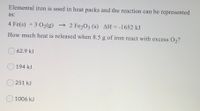
Chemistry
10th Edition
ISBN: 9781305957404
Author: Steven S. Zumdahl, Susan A. Zumdahl, Donald J. DeCoste
Publisher: Cengage Learning
expand_more
expand_more
format_list_bulleted
Concept explainers
Question

Transcribed Image Text:Elemental iron is used in heat packs and the reaction can be represented
as:
4 Fe(s) +3 O2(g) → 2 Fe2O3 (s) AH=-1652 kJ
How much heat is released when 8.5 g of iron react with excess O2?
62.9 kJ
194 kJ
251 kJ
1006 kJ
Expert Solution
This question has been solved!
Explore an expertly crafted, step-by-step solution for a thorough understanding of key concepts.
This is a popular solution
Trending nowThis is a popular solution!
Step by stepSolved in 2 steps with 1 images

Knowledge Booster
Learn more about
Need a deep-dive on the concept behind this application? Look no further. Learn more about this topic, chemistry and related others by exploring similar questions and additional content below.Similar questions
- A chemist measures the energy change AH during the following reaction: 2 NH3(g) → N₂(g) + 3H₂(g) Use the information to answer the following questions. This reaction is... Suppose 66.6 g of NH3 react. Will any heat be released or absorbed? ΔΗ= 160. kJ If you said heat will be released or absorbed in the second part of this question, calculate how much heat will be released or absorbed. Round your answer to 3 significant digits. endothermic. exothermic. Yes, absorbed. Yes, released. No. KJ x10 x Śarrow_forwardConsider these reactions: Reaction 1: H₂(g) + Cl₂ (g) 2HCl(g) AH-184.6 kJ Reaction 2: 20F2(g) O₂(g) + 2 F₂ (g) AH = -49.4 kJ Reaction 3: N₂(g) + 2O₂(g) · 2NO₂(g) AH = +66.4 kJarrow_forwardIn a constant-pressure calorimeter, 70.0 mL of 0.340 M Ba(OH), was added to 70.0 mL of 0.680 M HCI. The reaction caused the temperature of the solution to rise from 24.12 °C to 28.75 °C. If the solution has the same density and specific heat as water (1.00 g/mL and 4.184J/g · °C.) respectively), what is AH for this reaction (per mole H, O produced)? Assume that the total volume is the sum of the individual volumes. AH = kJ/mol H,Oarrow_forward
- Energy for recycling Cu: ________ kJarrow_forwardThe heat of reaction for the reaction A + 2B → 2C is 900. kJ.The heat of reaction for the reaction B + D → C is 150. kJ.Using Hess's Law, calculate the heat of reaction for the reaction A → 2D.arrow_forwardIn the following reaction, how much heat (in kJ) is released when 6.35 moles of CH4 are burned? CH4 (g) + 2 O2 (g) → CO2 (g) + 2 H2O(g) AH° = -802 kJ/molarrow_forward
- In the following reaction, what is the quantity of heat (in kJ) released when 3.91 moles of CH4 are burned? CH4 (g) + 2 O2 (g) → CO₂ (g) + 2 H₂O(g) AH° = -802 kJ/mol -arrow_forwardThe reaction between sodium metal and chlorine gas produces 822 kJ of heat energy for every chlorine molecule consumed [2 Na(s) + Cl2(g) → 2 NaCl(s)]. How much heat is released (in kJ) if 1.569 g of Na are consumed in the reaction?arrow_forwardIn the following reaction, how many moles of CH;OH are required to produce -2191 kJ of heat? 2 CH;OH (I) + 3 O2 (g) → 2 CO2 (g) + 4 H2O(g) AH° = -1280. kJ mol 1 3 4 6. C 7 8 9. + +/- x 100arrow_forward
- A 837837 g copper pan is removed from the stove at a temperature of 150 °C. It is then stacked on top of a 787787 g aluminum sheet at room temperature, 25 °C. The specific heat capacity for copper is 0.387 Jg·KJg·K and that for aluminum is 0.904 Jg·KJg·K. Assume no heat is gained or lost to the surroundings. What is the final temperature (?fTf) of the two objects after thermal equilibrium is reached?arrow_forwardHow many kilojoules of heat are produced when 6.04 mol of Al react? 2Al(s) + Fe2O3(s) → 2Fe(s) + Al2O3(s) heat of reaction = –851.5 kJarrow_forwardCalcium carbonate, CaCO3 is used as a calcium supplement. When it is heated, it decomposes to form calcium oxide and carbon dioxide. The energy used for the decomposition of calcium carbonate is y kJ. The balanced chemical equation for the reaction is a. CaCO3(s) → CaO(s) + CO2(g) ΔH = +y kJ b. 2CaCO3 (s) → 2CaO(s) + 2C(s) + 2O2(g) ΔH = +2y kJ c. CaCO3(s) → CaO(s) + CO2(g) ΔH = –y kJ d. 2CaCO3(s) → 2CaO + 2CO2(g) ΔH = –2y kJ e. none of the abovearrow_forward
arrow_back_ios
SEE MORE QUESTIONS
arrow_forward_ios
Recommended textbooks for you
 ChemistryChemistryISBN:9781305957404Author:Steven S. Zumdahl, Susan A. Zumdahl, Donald J. DeCostePublisher:Cengage Learning
ChemistryChemistryISBN:9781305957404Author:Steven S. Zumdahl, Susan A. Zumdahl, Donald J. DeCostePublisher:Cengage Learning ChemistryChemistryISBN:9781259911156Author:Raymond Chang Dr., Jason Overby ProfessorPublisher:McGraw-Hill Education
ChemistryChemistryISBN:9781259911156Author:Raymond Chang Dr., Jason Overby ProfessorPublisher:McGraw-Hill Education Principles of Instrumental AnalysisChemistryISBN:9781305577213Author:Douglas A. Skoog, F. James Holler, Stanley R. CrouchPublisher:Cengage Learning
Principles of Instrumental AnalysisChemistryISBN:9781305577213Author:Douglas A. Skoog, F. James Holler, Stanley R. CrouchPublisher:Cengage Learning Organic ChemistryChemistryISBN:9780078021558Author:Janice Gorzynski Smith Dr.Publisher:McGraw-Hill Education
Organic ChemistryChemistryISBN:9780078021558Author:Janice Gorzynski Smith Dr.Publisher:McGraw-Hill Education Chemistry: Principles and ReactionsChemistryISBN:9781305079373Author:William L. Masterton, Cecile N. HurleyPublisher:Cengage Learning
Chemistry: Principles and ReactionsChemistryISBN:9781305079373Author:William L. Masterton, Cecile N. HurleyPublisher:Cengage Learning Elementary Principles of Chemical Processes, Bind...ChemistryISBN:9781118431221Author:Richard M. Felder, Ronald W. Rousseau, Lisa G. BullardPublisher:WILEY
Elementary Principles of Chemical Processes, Bind...ChemistryISBN:9781118431221Author:Richard M. Felder, Ronald W. Rousseau, Lisa G. BullardPublisher:WILEY

Chemistry
Chemistry
ISBN:9781305957404
Author:Steven S. Zumdahl, Susan A. Zumdahl, Donald J. DeCoste
Publisher:Cengage Learning

Chemistry
Chemistry
ISBN:9781259911156
Author:Raymond Chang Dr., Jason Overby Professor
Publisher:McGraw-Hill Education

Principles of Instrumental Analysis
Chemistry
ISBN:9781305577213
Author:Douglas A. Skoog, F. James Holler, Stanley R. Crouch
Publisher:Cengage Learning

Organic Chemistry
Chemistry
ISBN:9780078021558
Author:Janice Gorzynski Smith Dr.
Publisher:McGraw-Hill Education

Chemistry: Principles and Reactions
Chemistry
ISBN:9781305079373
Author:William L. Masterton, Cecile N. Hurley
Publisher:Cengage Learning

Elementary Principles of Chemical Processes, Bind...
Chemistry
ISBN:9781118431221
Author:Richard M. Felder, Ronald W. Rousseau, Lisa G. Bullard
Publisher:WILEY